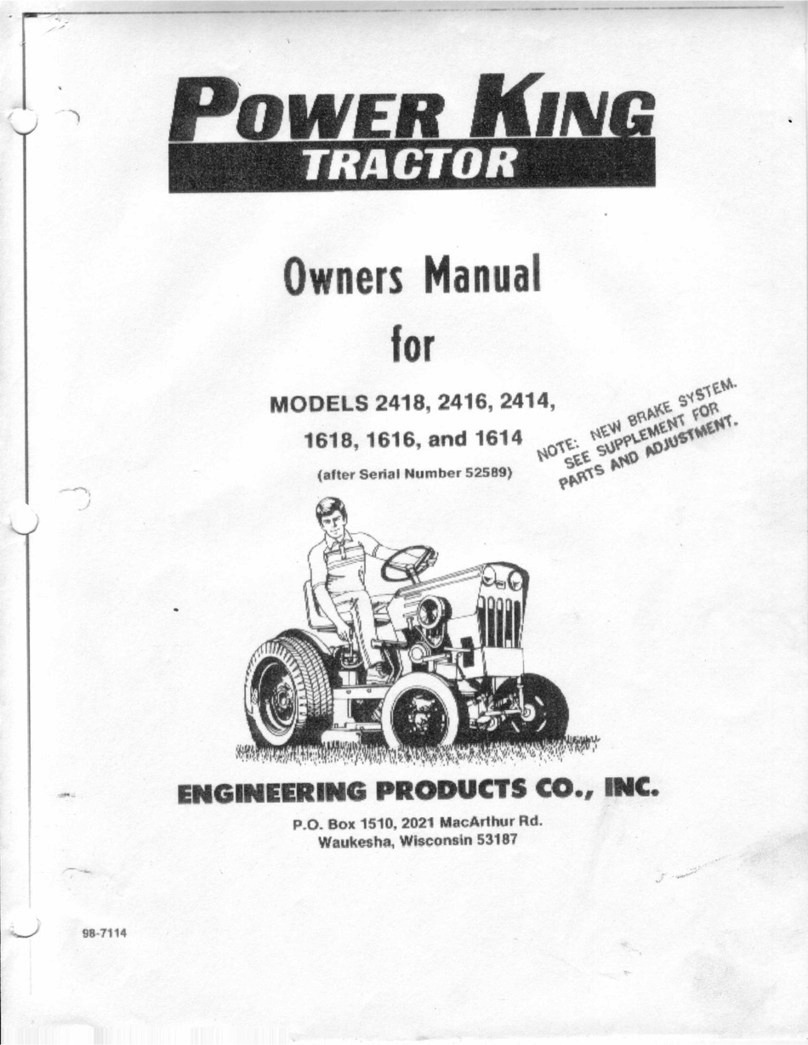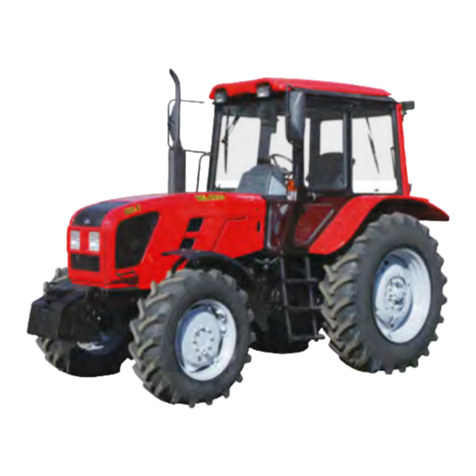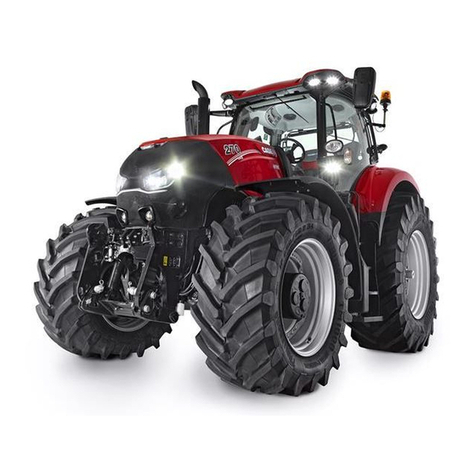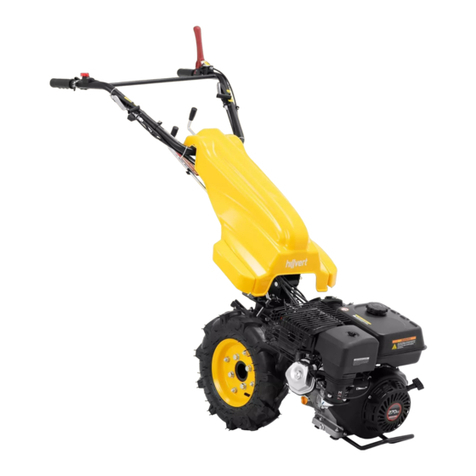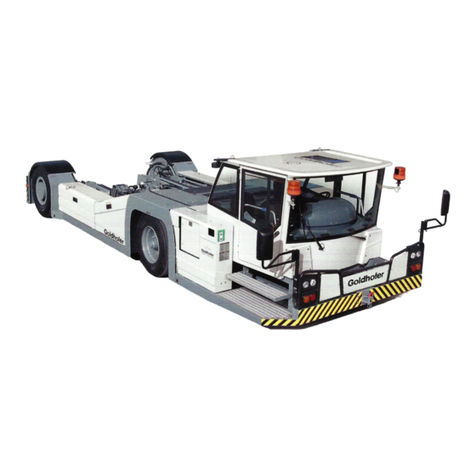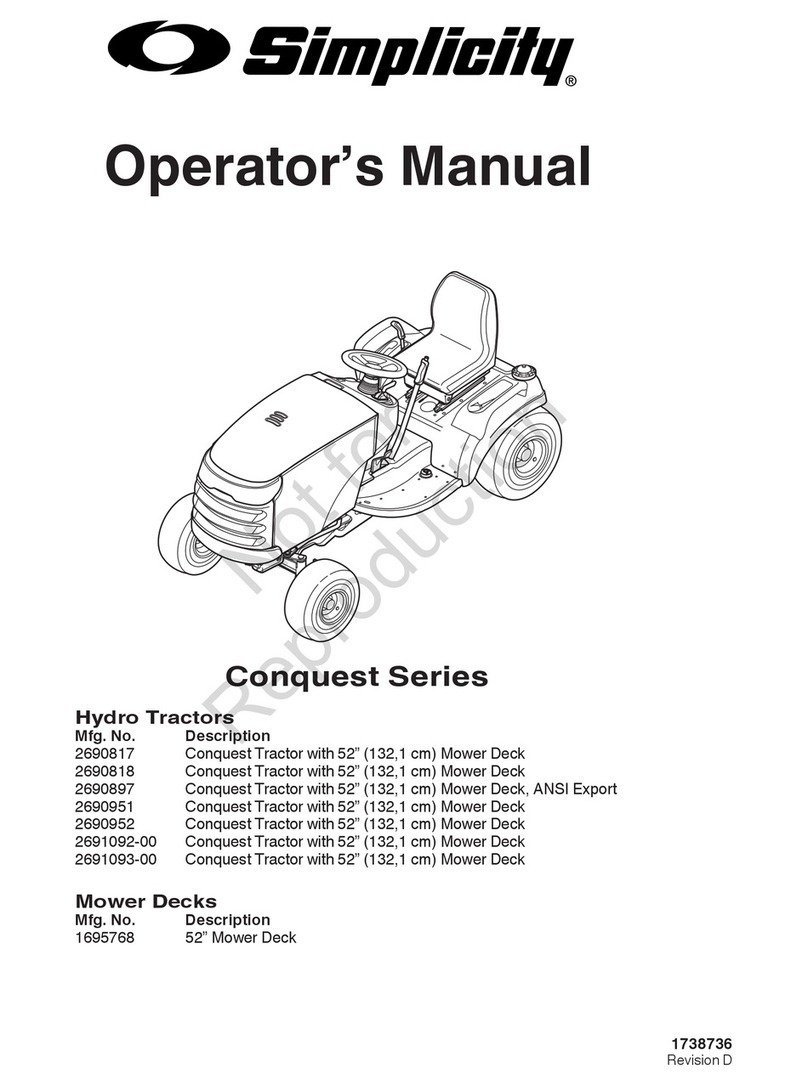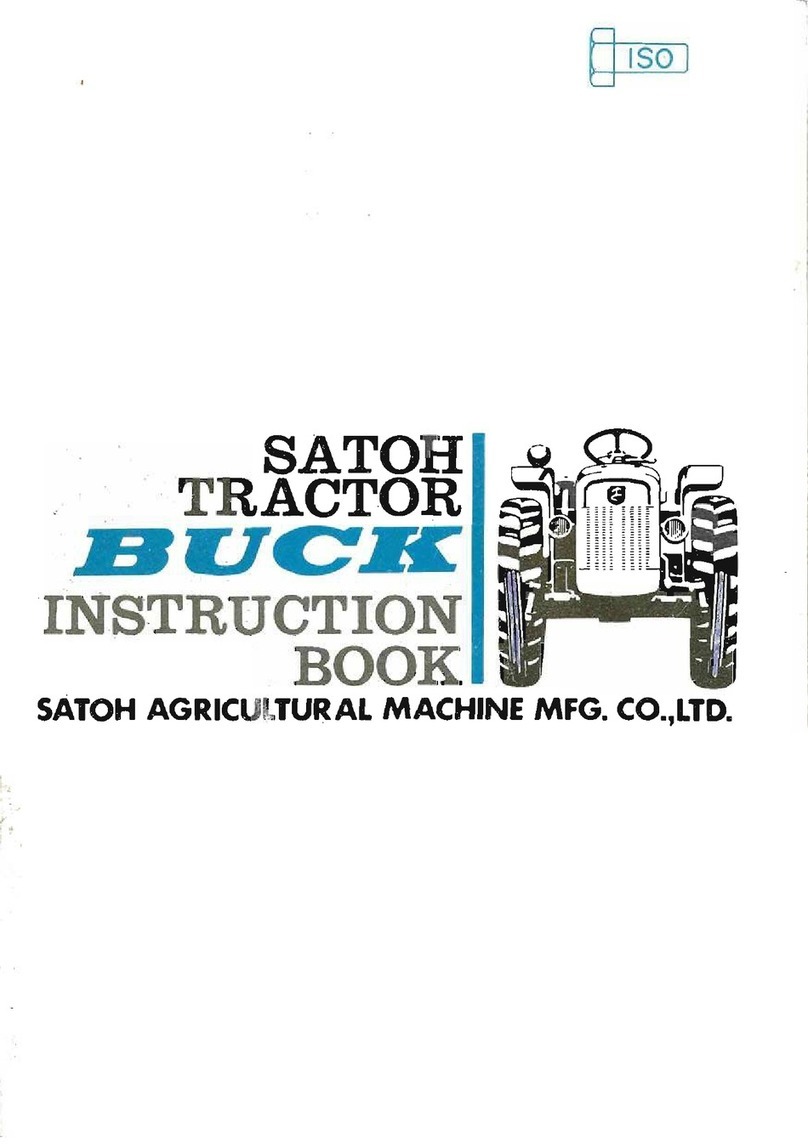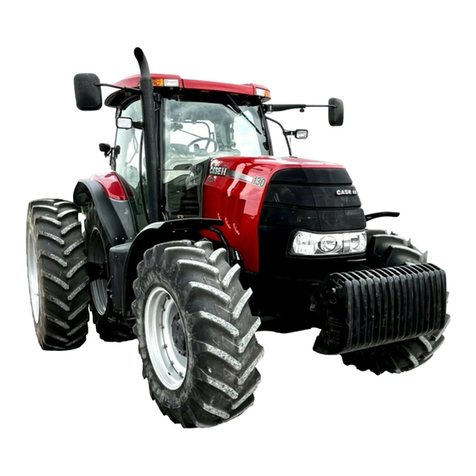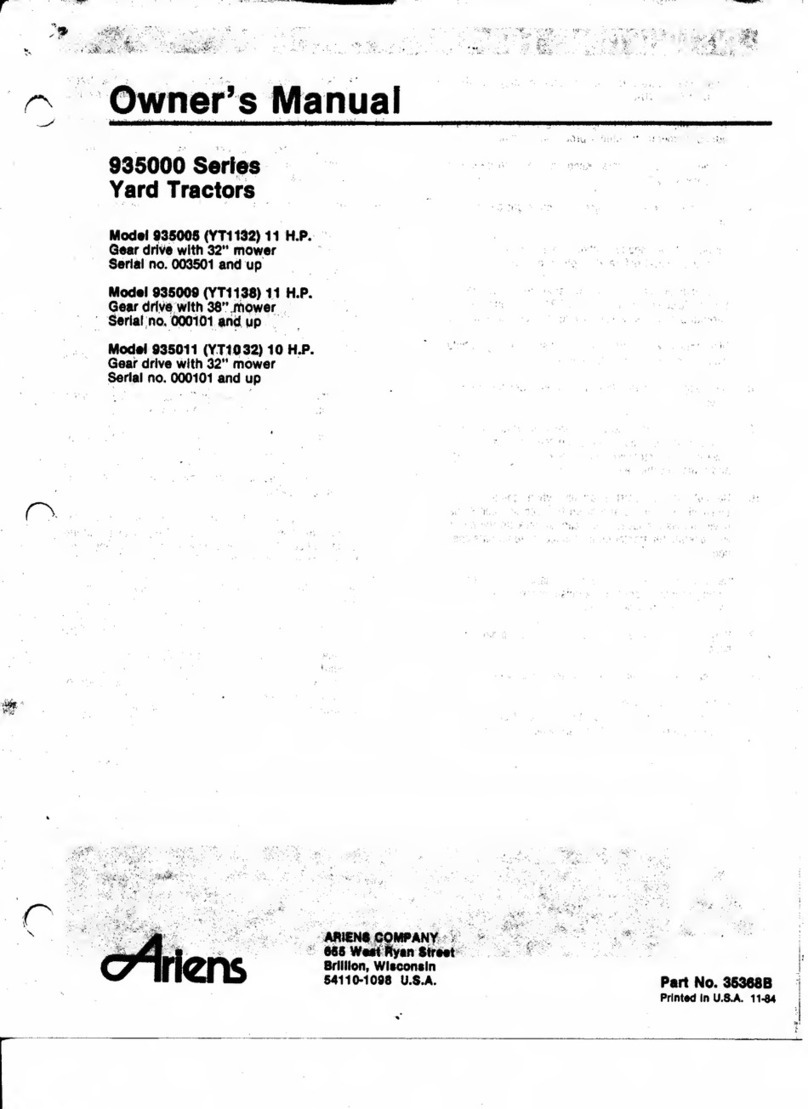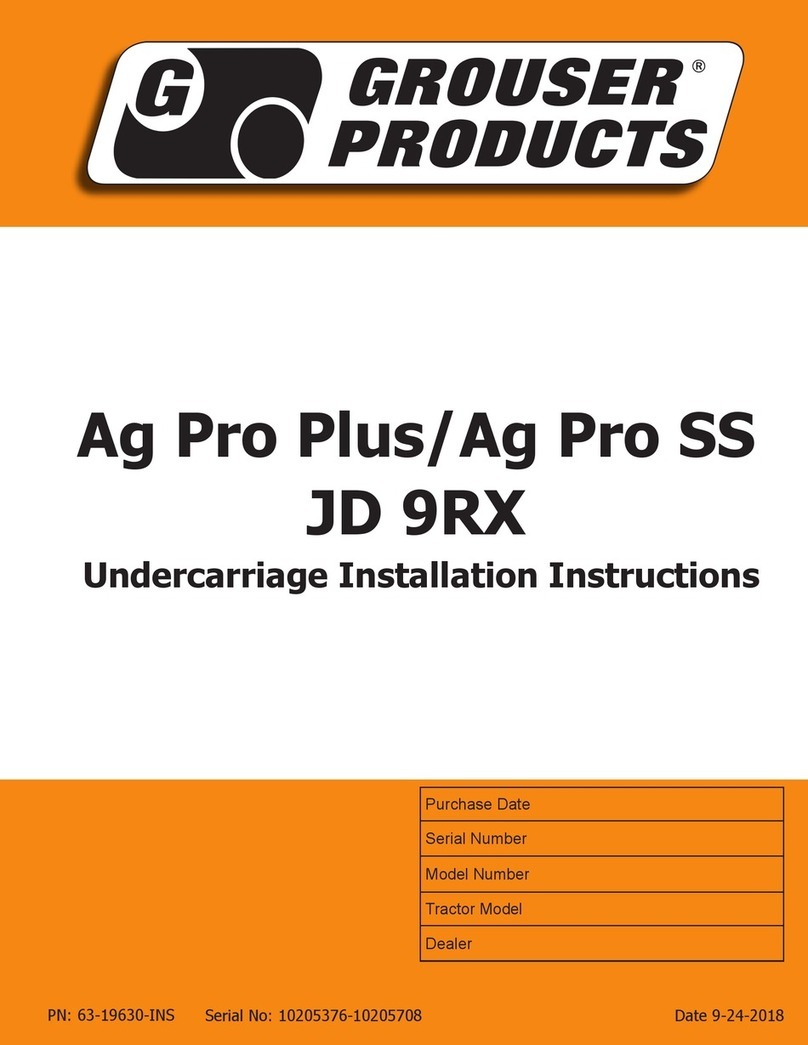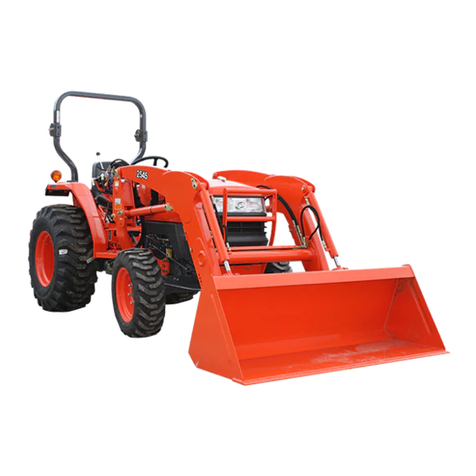ENGINEERING PRODUCTS POWER KING 1620 User manual

POWERKING
•
Economytractors
KEVCO
POWER
Lawn &Garden Equipment
Hwy. 202
es
an'c. N.J.
(201) 782-2545
•
Owner's
Manual
FOR
MODEL 1620 TRACTORS
from Serial Number
65861
IMPORTANT!A
READ THIS
MANUAL
COMPLETELY
BEFORE ATTEMPTING TO OPERATE TRACTOR
ENGINEERING
PRODUCTS
CO.,
INC
•
P.O. Box 1510
Waukesha, Wisconsin 53187 U.S.A.
(414) 785-0786
- - -
~---------"'-~----------~-----=-----~"""'"

INTRODUCTION
This manual contains operational, maintenance and adjustment instructions
for
Power King Model 1620
garden tractors.
We
urgeyou to read itthoroughlyand to understand its contents completely. Properuse and
careful attention to routine services and preventive maintenance practices are important factors in the
continuing satisfactory performance
of
the tractor.
It is agood idea to record the
model
and serial
number
of
your
tractor
as soon as
yo
get
it.
This
will
make
it
easier
to
order
repairparts if needed, and to
identify
the
tractor
ifstolen. Spaceis
provided
in
this
manual
for
that
purpose.
Certain references are made in this manual
to
right
or
left sides of the tractor.
This
is
determined
by
the
direction
the
operator
is facing when positioned in the
tractor's
seat.
A
number
of
safety
interlock
switches have been
incorporated
in this
tractor.
They are
provided
to
protect
the
operator
in various stages
of
starting and
running
the tractor. Be certain that these
switches
are in
operation
at all times.
IMPORTANT
NOTE
FOR OWNERS
LIVING
IN
CALIFORNIA:
The
engines
on
these t
actors
are
NOT
equipped
with spark arresting mufflers. Use
of
this
equipment
in grass, brush
or
forest land
without
a
properly
maintained
and
functioning
exhaust spark arrester is in
violation
of
California
State
Law
Section 4442 PRC.
TABLE
OF
CONTENTS
•age
Introduction . 3
Safety Rules "
Ii
Tractor Serial Number _ _. 5
Specifications _ _. . . .
..
6--
Controls .
8--
0
TractorOperation 11-12
Preventive Maintenance _ _ 13-16
Maintenance Chart
17
Lubrication Points .
18
Wheels and Tires _ 9
Tractor Storage
20
Adjustments and Repair
2~-22
Attachments . . . . . . . . . . . . . . . . . . . . . . . . . . . . . . . . . . . . . . . . . . . . . . .
23-2~
Minor Troubleshooting Guide .25-26
Parts Lists and Exploded View Drawings
Frame, Hood, Rear Body, Seat and Gas Tank . . . . .
.•
.
.•
_.
Console Assembly
....
.........................................................
...
. 2
Front End Assembly and Front Wheels
.............................................•..
29
Brake System .
__
_. . . . . . . . . . . . . . . . . . . . . . . . . . . . . . .
..
30
Electrical System
__
_
............•...........
3
Engines, Panels, and Drive Shaft _
__
_
.......•..............
32
Hydrostatic Drive Components
..................................•..........•......
33-~
Differential Assembly .
..
_ _
...........•...............
35
Final Drive Assembly and Rear Wheels _ .
Hydraulic Plumbing and Power Steering _. . . . . . . . .
..
.
.. ..
7
Auxiliary Hydraulic Lift System _
.............•............
, . 38
Three-Point Hitch . _
39
Appendix A
A-1
Appendix B . _
__
.
..
B-
Repair Parts Ordering, Maintenance and Serial Number Record I s de ac
Co
er
3

SAFETY RULES
AWARNING! A
CAUTION SYMBOL This symbol is placed
before instructions that must be followed to avoid
chance
of damage to property.
12. When using any attachment, never
direct
the
discharge
of material toward bystanders
nor
allow anyone
nearthe
tractor while
in
operation.
13.
Handle
gasoline
with
care
-it is
highly
flammable:
a.
Use approved gasoline container.
b.
Stop
engine
before removing the fuel tank
cap/gauge.
c.
Do
not
fill the tank indoors. Wipe up spilled
gasoline. Allow
wipe-up
rag to dry outdoors.
d.
Open
doors
if the
engine
is run in the garage
-exhaust fumes are dangerous.
e.
Do not run the engine indoors.
14.
Never store the tractor with gasoline in the tank
inside abuilding where fumes may reach an
open flame
or
spark.
Allow
the
engine
to
cool
before storing in any enclosure.
15.
Keep
the
tractor
and
attachments
in
good
operating condition, and keep safety devices
functioning properly at all times.
16.
Keep all nuts, bolts, and
screws
tight to be sure
the
equipment
is
in
safe
working
condition.
17.
To reduce fire hazard, keep the engine free of
grass, leaves, or excessive grease.
18.
The
tractor
and attachments should be stopped
and inspected for damageafterstriking aforeign
object. Any damage should be repaired before
restarting and operating the equipment.
19. Do not
change
the
engine
governor
settings
or
overspeed the engine.
20.
When using the tractor with amower, observe
the follOWing additional precautions
a.
Before starting to mow,
check
mower
care-
fully to insure that it is properly installed and
all nuts and bolts are tight.
b.
Determine
the
best
method
of
mowing
according
to size, terrain and obstructions in
the lawn.
Check
the lawn for any foreign
objects
which
might be picked up and
thrown
by the mower.
c.
Mow
only in
daylight
or
in
good
artificial light.
READ THESE SAFETY INSTRUCTIONS CAREFULLY AND FOLLOW THEM CLOSELY. FAILURE TO
ADHERE TO THESE RULES COULD RESULT
IN
LOSS OF VEHICLE CONTROL, PERSONAL INJURY TO
YOURSELF
OR
BYSTANDERS, PROPERTY DAMAGE
OR
DAMAGE TO THE EQUIPMENT.
WARNING SYMBOL
AThiS
symbol is placed
before instructions that must be
followed
to avoid
chance
of
injury
or
danger
to human life; and it also
applies to all information
in
this safety section.
4.
Be sure PTO switch is in "OFF" position, opera-
tor
is seated, and speed and direction control
lever is in neutral before attempting to start the
engine.
5.
Take all possible precautions when leaving the
tractor
unattended, such
as
disengaging the
powertake-off, lowering the attachment, setting
the parking brake latch with
your
foot, stopping
the engine, and removing the ignition key.
1.
Know
the
controls
and
how
to stop quickly.
Read all instructions carefully and familiarize
yourself with all controls.
2.
Do
not
allow
children to operate the tractor. Do
not
allow
adults to operate it
without
proper
instruction.
3.
Do notcarrypassengers. Keep area ofoperation
clear
of all persons. Keep children and pets a
safe distance away.
4
6.
Follow
Rule 5before making
any
repairs
or
adjustments
7.
Disengage PTO clutch when transporting or not
actually using attachment.
8.
Reduce
speed on slopes and in sharp turns to
prevent tipping
or
loss of control. Exercise
extreme caution when
changing
direction on
slopes. Use maximum tread width and wheel
weights on slopes.
9.
Stay alert for holes in the terrain and other
hidden hazards
10.
Use care when pulling loads or using heavy
equipment:
a.
Use only approved
drawbar
hitch points.
b.
Limit loads to those you can safely control.
c.
Do not turn sharply. Use care
when
backing.
d.
Use counterweights on weight platform when
suggested in the
owner's
manual.
11.
Watch
out
for traffic when crossing or near
roadways.

d.
Do
not
stop
or
start
suddenly
when
going
up
or
down
hill.
Mow
up and
down
the face
of
steep slopes; never across the face.
e.
Never
makeacutting heightadjustment while
the
engine
is running.
f.
Stop
the
engine
before attempting to
unclog
the
discharge
chute.
g.
Check
the blade
mounting
bolts for
proper
tightness at frequent intervals. Keep blades
sharp and in balance.
h.
Engage
mower
with
engine
in
low
rpm.
Tractor
engine
should operate at
1/2
to full
speed
for
mowing
operation.
Regulate
ground
speed with transmission settings.
i.
Always
look
behind when
driving
tractor in
reverse. Do
not
mow
with tractor in reverse
gear.
I.
Never
grasp
the
edge
of
the
mower
deck
or
reach
under
it while the
engine
is running.
21.
Remove
body
sections, drain the fuel, run
engine until remaining fuel
is
used, and
disconnect
the rectifier leads before
performing
any electrical welding on the frame.
22.
Operator's
clothing
should be free
of
tears,
bulging pockets, frayed edges and heavy cuffs.
23.
Wear heavy shoes (with steel toes if possible).
24. Wear ear muffs in
conditions
of
excessive noise.
25. Wear arespirator in extremely
dusty
conditions
and when using dusters. sprayers, rakes,
sweepers
or
blowers.
26. Wear safety glasses
or
goggles
that have
tempered
or
unbreakable lenseswhen operating
dusters, mowers, sweepersand blowers
or
when
operator's eyes are exposed
to
dust
or
insects.
Do not wear glasses.
goggle
or
sunglasses
made
of
ordinary
shatterable material.
27. Keep alert. Fatigue, worry, preoccupation, and
illness
work
against safety. Drugs and alcohol
impair
aperson's skill and
judgment.
28.
Frequently read and review the safety rules and
maintenance schedules.
TRACTOR SERIAL NUMBER
The Serial
Number
of
your
tractor
is shown on a
decal placed on the
upper
dashboard panel. Record
this
number
in the space provided on the back cover
of
this Owner's Manual, and alwaysspecify
itand
the
tractor
model
number
if
it
is necessary
to
order
repair parts at some future time.
Figure
1.
Tractor Serial Number
5

SPECIFICATIONS
Lug. 2ply 8.0-16
(31-3/4"
00)
Lug, 4ply, .
Power Torque
Lawn, 2ply .
TIRES:
Rear:
Turf,4
ply rating .
Air
Pressure .
Load Capacity/Tire .101bs.
7501bs.
8.3-16
(31-5/16"
00)
181bs.
8501bs.
8.0-16
(31-1/4"
00)
101bs.
7501bs.
13.5-:5/
(30-3/4"
00)
101bs.
5951bs.
Front:
Rib,4
ply 4.0-12 4.0-12 4.0-12
(20-1/4"
00)
(20-1/4"
00)
(20-1/4"
00)
Lawn,2
ply .
Air
Pressure .
Load Capacity/Tire
DIMENSIONS:
Length Overall .
Wheelbase .
Width .
Tread, Rear .
Tread, Front .
Toe
In
.
Tread Adjustment, Rear .
Tread Adjustment. Front .
Height (at steering Wheel) .
Clearance (ground to frame) .
Turning Radius .
WEIGHT:
Base Tractor with Wheels
5
Ibs.
CaCI2per gal. water
Pair Rear Tires
Adds'
.
5Ibs. CaCI2per gal. water
Pair Front Tires
Adds'
.
Wheel Weight, Rear, Pair .
Wheel Weight, Fron!. Pair
,.
GROUND SPEEDS, MPH (Approx.):
Forward , .
Reverse .
401bs.
7501bs.
83"
57"
43-3/4"
35-3/4"
36"
±1/16"
+5-1/2"
+5-1/2"
50"
15-3/4"
43"
10161bs.
2621bs.
401bs.
1181bs.
471bs.
401bs. 401bs.
7501bs. 7501bs.
83" 83"
57" 57"
44"
43-3/4"
35-314" 35-3/4"
36" 36"
±1/16" ±1/16"
+5-1/2" +5-1/2"
+5-1/2" +5-1/2"
50" 50"
15-3/4" 15-3/4"
43"
43"
10241bs. 10021bs.
2661bs. 2621bs.
40
Ibs. 401bs.
1181bs. 1181bs.
471bs. 471bs.
o
to
7.4
oto 3.0
8-10
(19-1/2"
00)
12Ibs.-<'"'
14501bs.
83"
57"
54"
41-1/2"
38-1/2"
±1/16"
0"
0"
50"
15-314"
38"
10561bs.
4001bs.
501bs.
N/A
N/A
CAPACITIES (See LUbrication Chart):
Fuel Tank 8-1/4 Gallons (approx.)
Engine Crankcase:
20
hp Engine 3-1/2 Pints (approx.)
Differential 2Pints (approx.)
Final Drive Cases 1Pint Each
Hydraulic Oil 2-1/4 Gallons
'Each
tire
75%
filled (25% air).
Engineering Products Co., Inc. reserves the right to make product improvements and change speclflcations without notice
or
obligation.
6

SPECIFICATIONS (Continued)
Kohler Model M140S, 14 hp at 3600 rpm 23.8
ft/lb
torque at 2200 rpm,
3-1/2"
bore x
3-1/4"
stroke,
31.27 cu. in. displacement balanced and governed
at 3100 rpm. Four cycle air-cooled, solid state.
Kohler Model M180S, 18 hp at 3600 rpm, 29.0
ft/lb
torque at 2600 rpm. Two opposed cylinders with
3-1/8"
bore and
2-3/4"
stroke. 42.18 cu.
in.
dis-
placement, governed at 3100 rpm. Four cycle, air-
cooled 15 amp negative ground battery ignition.
Kohler Model M20QS,
20
hp
at
3600 rpm,
33
ftllb
torque at 2600 rpm. Two opposed cylinders with 3-
1/8" bore and 3-1/16" stroke.
46.9
cu. in. dis-
placement, governed at
3100
rpm. Four cycle, air-
cooled
15
amp negative ground battery ignition.
Spin-On filter, engine head temperature sensor
and low oil sentry.
ELECTRICAL SYSTEM: Kohler: 12 volt starting
motor with Bendix type drive. geared
to
engine
flywheel. Three-position key switch, 15 amp. fly-
wheel-mounted alternator and rectifier-regulator
supply12-voltbattery current. Batteries:
45
amp. hr.
TRANSMISSION: Variable displacementhydrostatic
(by KYB). Displacement
16.4
cm3/rev.
DIFFERENTIAL: (by Dana Corp.) Hypoid. Reduc-
tion ratio:
5.17:
1.
FINAL DRIVE: Spurbull gearkeyed to 1-1/2" diam-
eter wheel axles. Reduction: 6.813:1.
ADJUSTABLE TREAD WIDTH: By reversing wheel
discs on hubs tread width may be changed. See
Dimension Table for maximum adjus ments.
POWER STEERING "GEAR": TRW
Ross
HGF-l0,
4.13cu. in.lrev., cylinderbo
e,
1.5"; ram, 5/8"; stroke,
5". Two turns full right to full left.
BRAKES: Cast drum and band. Individual or com-
bined actuation. Parking brake latch.
FRAME: Welded construction. Front wheel support
bar
1"
x
3"
~olid
steel; pivots on
1-1/2"
diameter
pivot stud and two bushings.
POWER TAKEOFF: Electro-magnetic
clutch
on
front ofengine drives mower
snow
blower, optional
PTO for tiller, and other
equipment
Asingle groove
pulley behind engine drives hydraulic system.
Engineering Products CO.,lnc., reservesthe
rightto
make improvementsand changeproductspecifica-
tions without notice or obligation.
7

8
ADJUSTABLE
SEAT
THROTTLE
STEERING
WHEEL
\
FUEL TANK
WITH GAUGE
Figure
2.
Tractor
Controls
HEADLIGHT SWITCH
PTO
SWITCH
IGNITION
SWITCH
BRAKE PEDAL
WITH LATCH
HYDRAULIC
LIFT HANDLE

CONTROLS
Be sure you are familiar with and
know
how
to
operateeach ofthetractor's controls before attempt-
ing to start and run
it
BASIC TRACTOR
Refer to the callout reference
in
Figure 2to identify
and locate each of the tractor's controls.
1.
IGNITION SWITCH. This is athree position, key
actuated switch. Turn the key all the way to the
right into the "START" position to start engine.
When released, the key will automatically return
left to the
"ON"
position. Turn key left to the
"OFF"
position to stop engine.
2.
HEADLIGHTSWITCH. When ignition switch key
is in the
"ON"
position, this knob
controls
the
tractor's headlights. Pull knob outto turn head-
lights on, push
in
to turn them off. (Note: Head-
lights will also go off when ignition key is turned
to
"OFF"
position.)
3.
THROTTLE LEVER. This lever controls the
amount
of
fuel being fed into the engine. Moved
upward, the engine's speed (rpm) will increase.
The speed will decrease when the throttle lever
is moved downward. Set lever midway between
the fast position (indicated
by
arabbit symbol)
and slow position (indicated by aturtle) when
starting engine.
4.
PTO CLUTCH SWITCH. This starts and stops
the electromagnetic clutch for the Power Take-
Off
on the
front
of
the engine. The switch
engages the clutch when pulled out and pushed
"ON", and disengages it when pushed "OFF".
5.
CHOKE KNOB.
By
cable extension this knob
controls
the'uel-air
mixture in the engine's
carburetor. The knob should be pulled outwhen
starting the engine and then pushed in shortly
after engine begins to run
6.
STEERING WHEEL. Controls the frontwheels of
the tractor for steering.
7.
BRAKE PEDALS. The left pedal controls the left
wheel brake and the right pedal controls the
right wheel brake. Pedals can
be
operated to-
gether
as
asingle unitby rotating the brake latch
arm on the back of the left pedal into the notch
on the right pedal
forthe
normal modeof opera-
tion (such
as
mowing). Each pedal can
be
oper-
ated independently
as
left or right wheel brakes
for turning with aheavy load
or
for
tight
turns.
Individual brakes
ca
also be used to stop one
wheel from spinningon ice
or
otherpoortractive
material. Always apply bra
es
gradually.
8.
SPEED AND DIRECTION CON ROL LEVER.
The hand operated control lever is used to
"START"
and/or
"STOP"travel
of
the tractorand
toselect its forward
or
reverse operating speeds.
Forward speeds can
be
adjus ed from 0to 7.4
mph and reverse speeds from 0
to
3mph. The
neutral ("N") position
as
adetent.
I\.
WARNING:
Always
make
certain
the
speed
..
and
direction control lever
is
in
the
neutral
detent
before
starting
or
getting
off
the
tractor.
Makecertain that clothing
or
other
objects
do
not
hook
onto
the
lever
when
getting
off
the
tractor.
9.
SPEED OVERRIDE PEDAL. T epedal
attheleft
of the console
is
used
for
neutral safety starts
and speed over-ride adjustments while travel-
ling. As the pedal is depressed. speed slows and
as
it
is
released, the speed
as
selected by the
hand lever will be resumed (this is similar to a
cruise control function).
10.
PARKING BRAKE. Fully depressing the brake
pedals,
once
they are locked together with the
brake latch, encounters the par ing brake arm
which
automatically
latches
and
holds
the
pedals
in
their depressed position. (Note: When
brakes are in this position. engine may be
started
or
will continuerunning withoutoperator
being in seat ifthe transmission is in neutral and
the PTO clutch switch is down.) Alight
down-
ward tap on the latch releases the pedals.
11.
HOOD LATCH. Retains the lower edges of the
hood preventing bounce on rough terrain.
12.
ADJUSTABLE
SEAT.
Contoured seat may be
movedforward
or
rea ard
up
to3". Loosen two
wingnuts on t e seat
support
plate
and
slide
seat assembly back or forth to
suit
Tighten
wingnuts.
BYPASS VALVES
When the
tractor
is to be hand pushed, the
appro-
priate "FWD" (forward)
or
"RE .(reverse) bypass
valve must be pushed
do
nand held down. Insert a
small screwdriver
or
similar object into the desired
actuator hole and depress he alve ac uator, hold
down while pushing the rac or.
9

LH Button
RH
Button
Controls Reverse Controls Forward
"Bypass Valves"
INSTRUMENT GROUP
HOUR METER runs when ignition switch
is
"ON".
Do
not
leave ignition "ON" when engine
is
not run-
ning.
Use
hourmeterto perform timelymaintenance.
VOLT METER senses battery condition. With igni-
tion switch on, butengine
not
funning. 12-14volts of
battery charge
is
normal.
ENGINETEMPERATURE LIGHTnormally off. Only
goes on if engine head temperature
is
excessive.
LOW OIL PRESSURE LIGHT. Detects low oil pres-
sure. During starting sequence this light should be
"ON"when the ignition switch
is
"ON"butthe engine
is
not running.
LIFT CONTROLS
THE HYDRAULIC LIFT CONTROL LEVER is located
on
the lowerright side of the dashboard. The lever
is
connected through the dashboard sheet metal
to
a
single-spool hydraulic control valve, and has four
10
operating positions:
(1)
"Hold"
position is in the
center.
(2)
Pulled to the rear, both front and rear
mounted implements will be raised. Released, the
lever will automatically return to its center position
and the implements will hold theirraised position.
(3)
Pushedforward, both
frontand
rear implements will
be lowered and, again, the lever will return to its
center position when released. And
(4)
Pushed fully
forward, through aslight detent, will allow the
implements to "float," or seek their own best oper-
ating level.
In
this case, the lever will remain
in
the
forward position until pulled out of the detent.
An
auxiliary lift kit is also available which, when
installed
in
addition to the standard hydraulic lift
system above, will allow rear mounted implements
to be raised or lowered separately and independ-
ently of front
or
mid-mounted implements. Control
lever action is the same as described above.
Lift Decal

TRACTOR OPERATION
Your
Power
King Tractor is equipped with safety
devices
which
HELP prevent unsafe starting and
operation. However, there is no substitute for good
judgement. PERFORM the daily inspection and
maintenance desc ibed in the maintenance portion
of
this manual.
NOTE: Safety interlocks prevent the engine from
starting unless: the speed override pedal
is
fully
depressed, the operator
is
in the tractor seat, PTO
switc
is
"OFF".
ENGINE
CANNOT
BE STARTED UNLESS:
1.
Speed override pedal
is
depressed.
2.
PTO switch is OFF (DOWN).
3.
Operator is in seat.
ENGINE KILLS (STOPS) AFTER STARTING
IF:
1.
PTO switch is
ON
and operator leaves seat.
2.
PTO switch is OFF, but operator leaves seat
without engaging parking brake latch. Figure
4.
Controls Set
for
5 . g Engi e
9power is
9motor, imit
eexcept push
ne armsup.
art.
s
safety interlock prevents
tee
g'ne
from start-
ing if the PTO clutch is ega ed.
2.
Check to besure thespeed a d direc ion control
lever is in neutral
POSltlO
Depress speed over-
ride pedal.
3.
Pull the
cho
e
ob
out
and
se
t e hrottle lever
up about half way be
ee
slo a d fast.
4.
Turn the ignrtion ey 0
ART'
position. Re-
lease the key
as
SOO'1
as
e g e starts. Push
choke knob in.
5.
After engine s e lever
down
until engine Js
1.
Keep bat er
J",
greatly
red
Ced
a
2.
Do
not use star' g
3.
Folio
sa
e
chokek
a0
4.
Use
lighter 0
STARTING ENGIN
IN COLD WEATHER
FIgure
3.
Fuel Shutoff Valve
1.
The PTO clutch must be disengaged. Do this by
pushing the switch on the dashboard to"OFF". A
TARTING THE ENGINE
Be sure the fuel valve on the bottom side
of
the fuel
tank is open. (See Figure
3.)
The valve
is
closed
when it is turned in. Turnout (counterclockwise) all
the way
to
open.
11

SETTING TRACTOR AND
ATTACHMENT IN MOTION
ACAUTION: Check to be sure that the area
~
around the tractor and attachment, and in
the path you intend to travel,
is
clear of people,
pets and other obstructions.
1.
To
bring the tractorinto motion, movespeed and
direction control hand lever slowly from its
detent (Neutral) position to the desired speed
and direction.
2.
To
change acontinuous operation speed set-
ting, use the speed and direction control lever.
To temporarily reduce speed, use the speed
override pedal.
3.
If aPTO driven attachment, such
as
arotary
mower,
is
being used, engage the electromag-
netic clutch, pushing the
PTa
switch to "ON"
before moving the speed and direction control
lever
out
of
neutral
or
increasing engine rpm.
After both engine and attachment are running,
gradually increase engine rpm up to operating
speed. Refer to specific attachment instructions
for additional information.
NOTE: Asafety interlock switch automatically
stops the
PTa
driven attachment if the operator
dismounts
without
first pushing the
PTa
clutch
switch to "OFF" and engaging parking brake
latch
4.
Operate
throttle
as required. Engine speed
below half throttle is not recommended since
PTO driven attachments are designed to oper·
ate at 2400 to 3100 rpm. However, the
lower
the
engine speed, the longer your engine will last,
provided itis notso
low
thatthe engine
"strains"
under load.
SELECTING TRACTOR
SPEED RANGE
Tractor
ground
speed requirements will vary with
the
conditions
under which the
tractor
is
to
be
oper-
ated and the attachment being used. The
PTa
driven attachment drive
is
independent of the trans-
mission setting so the tractor may
be
slowed down
without
reducing the speed of the
attachment
The
speed over-ride pedal may be used to slow down the
tractor
without
braking. When the speed over-ride
pedal
is
released, the tractor will resume speed
as
selected
by
the speed and direction control hand
lever.
12
DRIVING THE TRACTOR
1.
Stay
away
from ditches, holes, banks and other
areas that could cause tractor turnover.
2.
Go
slowly
and
use extreme caution on slopes,
grades and rough terrain, when turning
around
and when view
of
the ground is obstructed.
3.
When operating on slopesandgrades, use
front
and rear wheel weights and
low
speed ranges.
4.
Usefront
...
"heelweightsorfrontbumpercounter-
weights when pulling loads. Use
low
speed
ranges and apply
power
slowly. Pull
from
frame-
mounted
towbar
only. Do
not
pull from any other
place on the tractor frame.
5.
Observeall safety rules printed atthe beginning
of this manual. (See page
4)
6.
Never dismount until tractor is stopped, all
power
shutoffand parking brake latch engaged.
7.
Never leave the
tractor
unattended with the
engine running.
8.
Never leave the ignition key in an unattended
tractor.
9.
Do
not
disconnect
any
safety interlocks. They
are provided for the protection
of
the operator,
especially when his
or
her
attention may be
momentarily distracted.
STOPPING THE
TRACTOR AND ENGINE
1.
To
stop motion
of
the tractor, return the speed
and direction control hand lever in "Neutral"
detent position. Lock both brake pedals together
and latch them
into
the engaged position. Push
the
PTa
clutch switch to "OFF" position.
NOTE: Safety interlocks will be actuated and
engine
will stop automatically if these steps are
not taken before operator leaves seat.
2.
Allow
the engine to
idle
down
for at least 60
seconds and then turn ignition key to the
"OFF"
position.
"DIESELING" ENGINE pull
choke
knob out to
flood engine.
DISMOUNTING
TRACTOR
WITHOUT
EN-
GINE
KILL
PTa
switch must be "OFF". Brake
pedals locked togetherand latched into engaged
position.

PREVENTIVE MAl TENANCE
GENERAL
The tractor should be checked and serviced at
regularintervals.Some checks and servicesshould
be made daily; other checks may be performed at
longer
intervals.Alittle time spenteach daywill help
in keeping maintenance costs down and will make
the tractor safer to operate. Regular inspection
of
thetractorwill help locate minorproblems thatneed
attention. Prompt correction of minor trouble can
prevent an accident or breakdown later.
MAINTENANCE LOG
It is a
good
idea for the
owner
to keep alog
recording maintenance and repair activities on his
tractor.
Accurate
records can be helpful
in
deter-
mining the length of time between maintenance
operations.
CLEANING
Keep the tractor free of debris,
dirt
and grease.
Remove mud, ice
or
snow from the tractorafter use
to prevent hardening
or
freezing.
Be
sure screens
are clear. Cleaning may help in the discovery of
minor difficulties before they become troublesome.
The side panels covering the oil coolers should be
removed and the coolers washed
off
to prevent
clogging.
LUBRICATION
Refer to the lubrication chart for lubricants and
service intervals. Always clean the exposed areas
of
the dipstick, filler plugs, grease fittings, and the
areas around these parts before lubricating or
checking lubrication.
NEW TRACTOR FIRST USE LUBRICATION
Detailed descriptions and photos in this section
should be read and referre to when using the
following summary.
1.
Check engine cran case
i.
differential, and
axle oil fill levels. Chec ba eryele rolyte levels.
NOTE: The use
of
brea - r non-detergent oil
is
NOT recommended.
2.
Use for 5hours in lightto medium dutyserviceto
"BREAK-IN" moving parts.
3.
Change engine oil.
4.
Grease all working join s
as
indicate in figures
M-3 and M-4 on page
18.
5.
Rinse any excess (boiled over) batteryacidfrom
engine compartment areas.
6.
Readjust belt alignment as equired.
7.
Tighten loose faste ers.
8.
Check and replenish
hy
raulic oil remove the
cap at the left
front
of
thesea and fill to
3"
below
top
of
the hydraUlic an .Implement lift
cylinders must
be
retract when checking
hydraulic oil level. Refer Figure
M2
on page
18.
Asmall neck fun e
'-
required.
it..
CAUTION: Do n t overfill
the
hydraulic
~
tank. Approximately 3"
of
air space
Is
re-
quired
to
allow for ermal expansion
of
the oil.
HOOD A D BODY SECTION
Removal of fender body can facilitate cleaning and
lubricating,b
tis
ge erallynotnecessary. However,
removal instruct ons are
co
ered
In
the ADJUST-
MENTs section auld 's be desired.
13

Maintenance and repair supplies referred to
below
can be obtained at automotive parts dealers
or
discount store automotive departments.
Use apremium paste wax on hood, body and dash
areas every 6months
in
order to maintain asmooth
surface finish and color.
Use of
"rubbing"
compound
can remove small
scratches. Touch up paint may be required for larger
damage.
Major
damage can be repaired easily and
inex-
pensively with an automotive body fiberglass repair
kit and touch up paint.
ENGINE
NOTE: If differences are encountered, the engine
manufacturer's Owner's Manual should override
the following.
The three main causes of major engine failure are:
1.
No oil
or
dirty
oil.
2.
No cooling air.
3.
Dirty
carburetor
air.
CHECKING OIL
Dipstick and oil fill are on top of engine. See Figure
M-1
on page
18.
To
check
level, pull dipstick completely out of the
crankcase,
wipe
off oil, reinsert dipstick completely
into the oil, remove and read level.
Oil should be maintained between low
(L)
and full
(F)
marks. Do not overfill.
CHANGING
OIL
The engineoil and filter should be changed afterthe
first 5hours of operation, and every
25
hours
thereafter
Drain oil while engine
is
hot.
Hot
oil drains more
freely, and carries away more impurities. Remove
engine drain plug and filter. Drain oil into pan.
Replace plug and filter. Refill
to
full
(F)
mark on
dipstick. Clean up spilled oil.
AIR CLEANER
Aclogged air cleaner
reduces
engine
power
and
leaves unburned fuel in the engine.
The
air cleaner
is either oftwo types: a
dry
elementfilter with afoam
pre-cleaner
around
it,
or
a
dry
filter element alone.
If
so equipped, clean the
pre-cleaner
daily, or more
often in dusty conditions. Water and detergent may
be used only on the foam pre-cleaner. Lightly oil
after cleaning.
14
The
dry
element removes dust as
air
circulates
through its
porous
paper surfaces. Replace element
if
rubber
gaskets
or
paper
surface
is damaged.
HANDLE CAREFULLY.
DO
NOT OIL.
~-WINGNUT
o - AIR
CLEANER
COVER
. . ELEMENT
0--
COVER
SEAL
~-----ELEMENT
COVER
~
aRECLEANER
1!
ELEMENT
o
TO SERVICE:
1.
Remove
wing
nut from cover.
2.
Remove cover.
3.
If installed, remove pre-cleaner. Shake
out
debris. If
necessary
wash, rinse,
dry
and
lightly oil.
4.
If
dry
element is not damaged,
or
not
too
dirty, gently tap on flat surface to dislodge
dirt
and debris.
DO
NOT WASH OR OIL.
5.
Check
back
plate to be sure
it
is
securely
mounted and undamaged.
6.
Reassemble.
ENGINE COOLING SYSTEM
The
tractor
engine
is
air
cooled.
Air
is
drawn
intothe
area
around
the
engine
from the rear by fins
provided on the flywheel.
To
prevent the
engine
from overheating
or
burning out, the rotating air
screen and the cooling fins on each
block
and
cylinder head must be kept clean and unobstructed
at all times.
To
check this, proceed as follows:
1.
Unlatch and raise Fiberglass hood section.
2.
Check the engine intake screens and oil cooler
compartment
located between the console and
engine. Clean if needed. Adirty screen will
cause theengine tooverheat.
See
"Transmission
Oil Cooler," page
16.
3.
Remove air
duct
around the muffler and clean
the
cooling
fins on the engine. Be careful not to
touch the mufflerif cleaning is
done
immediately
after use. Replace the duct.
4.
Close and latch the hood.

n(see
Figure30n
efuel tank, fuel
pand carbure-
i engine.
5.
With fuel lineshutoff al
eo
page 11), check for leaKs .
~
lines and connections.
uC::
tor. Correct all lea sbefo"e sa
4.
Check the fuel tank cap to be sure the breather
hole is open. If itis plugged, avacuum is created
and fuel cannot be dra nfrom the tank by the
engine's fuel pump.
SPARK PLUGS
Afterevery 100 hours
of
use check the condition of
each spark plug and reset the gap. The gap gradu-
ally widens
as
the electrodes wear under normal
conditions. Check each plug
as
follows:
1. Open the hood, disconnect the lead wire from
thetop ofthe plug.
2.
Before removing plug, clean it and the area
around it
.to
prevent
dirt
from dropping into
engine.
6.
When the tractor
ie,
sh
ut-offvalve should
<:>
: e rear fuel
S9
-rclockwise).
3.
Remove spark plug, using care not
to
crack or
break ceramic insulation material.
4. Check condition
Of
electrodes. If the plug has a
lightcoating ofgrayortan, this usually indicates
normal conditions. Awhite, blistered coating
may
indicate
overheating. A
black
coating
usually comes from operating with
an
over-rich
fuel mixture.
5. Do not attempt to service aspark plug that
is
badly fouled
or
in poor condition. Replace both
plugs when one requires replacement.
6.
Ifthe old plug
is
in good condition, reset the gap
to .025 inch.
7.
Using atorque wrench, tighten each plug of the
twin cylinder engine to 10-15 ft-Ibs.
8.
Reconnect lead wires from coil and close and
latch hood.
FUEL FILTER
To
removethe fuel filterforelea 9
or
re
lacement,
close the fuel line shutoff val e a d sconnect fuel
line at the fuel shutoff valve.
Re
e e shutoff
valve and drain the fuel from t
eta
asuitable
container. Pull entire shutoffval
eo
....
of
ta
kwith a
twisting motion. Rinse filter in c
ea
f
e.
Reinstall
and fill fuel tank. Check figure
3,
page
11.
BATTERIES
The tractor battery condi Id be checked
every 25 hours
or
each ee 0
eratio.
Checkas
follows:
1.
Unlatch and raise ood.
~e
a
ery
is located
immediately in front of as oard.
2.
Check the electrolyte
Ie
eof the battery by
removing the filler caps.
FUEL SYSTEM
1. Check gauge
in
fuel tank cap behind seat for
fuel remaining
in
tank.
h
WRING:
Do not smoke or light amatch
..
while caps are remo
ed.
If the
battery
has
been charging, hydrogen gas is present and
potentially explos'
e.
asled water
--e
UUliUIT'
of
t e filler
3.
If the elec r
coveri g
tube. 0
4.
If water
weat
e'
This
preve
5.
elea
c
rr
Sa
dlr
from cables.
connec-
tions
a""
of oa ery. 0
r'
a d corrosion can
cause
se
-d
schargrng of bat ery. Apply acoat
of a
co
ros on reventatJ e0ermi als.
6.
Tighten batteryconnec 0
s.
Kee connections
tight at all times to pre etarci
g,
pitting
of
connections, and e e a attery failure.
hWARNING: Before adding fuel, turn off all
..
electrical systems including headlights.
Do
not
permit smoking in the area. Keep flames
and sparks away from the area.
2.
Clean areaaround thefuel tank cap and add fuel
as required. Use fresh, regular grade of un-
leaded gasoline with
an
octane rating ofatleast
87.
DO NOT ADD
Oil
TO THE GASOLINE. DO
NOT USE GASOLINEIALCOHOL BLENDS.
3.
Wipe off any spilled fuel with rags. Allow spilled
fuel and vapors to dissipate before turning on
any part
of
the electrical system including the
ignition. Place
wipe-up
rags
in
awell ventilated
area for drying.
15

BATTERY CHARGING
WARNING: Dangerous Acid,
Explosive Gases
Batteries contain
sulphuric
acid. Avoid
contact
with
skin, eyes, andclothing. Batteries
produce
explosive
hydrogen gas while being charged. Ventilate the
area when charging the battery. Keep cigarettes,
sparks, open flame,
and
other
sources
of
ignition
away
from battery at all times. Keep batteries
and
acid
out
of
the reach
of
children. Remove
all
jewelry
when working on battery.
A.
CAUTION: Do
not
apply 12-V
DC
to
kill
~
terminal
of
ignition module
as
module will
burn out.
TRANSMISSION OIL COOLERS
The hydrostatic transmission oil
is
cooled in oil
coolers. These coolers must be kept clean and
unobstructed to prevent overheating of the trans-
mission.
To
clean:
1.
Unlatch and raise the hood.
2.
Remove the protective sheet metal panels at
both sides ofthe coolercompartment. Each side
16
panel is retained by
four
screws, lockwashers,
and flat washers.
See
Figure
MS,
page
18.
3.
Use abrush and/or water under moderate pres-
sure to clear
out
the oil cooler compartment.
4.
Visually inspect the cooler fins and carefully
remove any debris caught between the fins.
Separate any fins which are touching each
other.
5.
Replace the side screens and mounting hard-
ware and close and latch the hood.
HYDRAULIC OIL FILTER
The transmission oil filter should
be
replaced every
100 hours. Gain access to the filter from beneath the
tractor. Unscrew the filter and replace with anew
filter. See Figure
M6,
page 18
DRIVE BELTS
Check PTO and attachment drive belts periodically
for wear, cuts, breaksand frayed condition. Replace
worn or damaged belts with Power King replace-
ment belts.

AINTENA CE A 0 LUBRICATION CHART
Detailed descriptions
and
photos
in
this
section
should
be
read
and
referred
to
below.
ummarychart
ACTION
REFER
TO COMME T
RVAl
Damage -wea
f'':-,"
:-
Connected -in place
Present &tight.
Alignment -conditio ,
Fill
as
required.
SAE
30
above
32
c
;=
SAE 5W30 belo
32=
=
Fill to 3" of top
of
,~..,
ISO VG46 hydra
...
(Engineering
Pr
u':··
-
#98-4001-00),
or
_
,..,~
Don't permit grass. dirt,
s~
~
_
__
to remain on tractor
or
a~a:-
-=-',"
after use -grease as
~.:~::::
Clean and straighte
"s
Fig.
M-'
Fig. M-5
Fig. M-2
Fig.
M-'
ENGINE
OIL
&FILTER
•Air intake screens
•Air cleaner
VISUAL INSPECTION
•Safety switches
•All guards &shields
•Fasteners
•Belts
•Oil Coolers
CLEAN
FUEL LEVEL
HYDRAULIC
OIL
&FILTER
-=
...
:_~
ENGINE COOLING FINS
BATIERY
AND SPLASH SHIELD
ELECTRICAL SYSTEM
TIRES
BRAKES
SPARK PLUG
FUEL FILTER
ENGINE OIL FILTER
HYDRAULIC OIL FILTER
GREASE
FITIINGS/KNUCKLES
(WORKING SURFACES)
M-6
Figs. M-3
to M-4
Remove sheet lY'e:a
~;:
sa--
Check electrol
,,~:
=a-
::''7'='
Check &
clear
a
::
--
_:'
,
-.:.
Replace
'8'
~
=~"_=
Replace f:6" __ _
Replace <
'E'
~
__
_
Lithium
:-a-::
;;
:::=~
---.....-,
--
...........
FINAL DRIVE Fig.
M-l
80/90
gea'
_='=
3/4 to
1,'
2:
- _
•
17

M2.
Hydraulic
Oil
Reservoir
Tank
Fill
Cap
HYDRAULIC
TANK
FILL
CAP
LUBRICATION POINTS
~
-:
...
~-~~.
.
...
••
~
,.
".
,,.
M1. Engine Dipstick and Fill Plug Drain Plug on
Right BoHom, at Middle
01
Engine
011
Filter
M3. Fron!
Support
Bar Grease
Filling
M4. Front Wheel Grease
Filling
MS.
Hydraulic
011
Cooler M-6. Hydraulic
011
Filter
M7.
Gear
Case
Check
and
Drain
Plugs
M8. Differential
and
Gear
Case Fill
Plugs
18

WHEELS AND TIRES
TIRE CARE
Proper tire maintenance
is
oneof
the most
important
factors in the satisfactory performance
of
your
tractor. Observe the following tire care rules
for
best
results:
1.
Immediately wipe spilled oil
or
gasoline from
tires. Do not park in spilled oil. Petroleum
products
attack rubber. Clean chemicals from
tires
as
soon
as
possible.
2.
Avoid sharp objects which
may
cut
or
puncture
tires.
3.
Avoid
"bruising"
tires by striking hard objects
with
heavily loaded
tractor
or at high speeds.
4.
Do
not
"spin"
tires
during
start-up.
5.
Do
not
brake to skidding stops.
6.
Maintain proper inflation:
•
Under-inflation
may cause rim slipping,
excessive wear and alow or uneven
cut
when
mowing.
An under-inflated tire may
appearto
be
properly
inflated
but
will buckle when the
tractor
pulls aload and sidewalls will eventually break.
•Over-inflation may cause the rear wheels to
slip
under
load and cause faster tire wear
as
a
smaller part
of
the tire
is
in
contact
with the
ground.
When operating amower, the cut will
be
higher
than setting.
• A
correctly
inflated tire results in good traction
with the least wear. The recommended pressure
may vary,
depending
upon
the load on the
tractor
wheels.
TREAD WIDTH
Tread width,
as
used here, refers to the spread or
spacing between the
center
lines
of
the two rear
wheels or the
two
front
wheels
of
the tractor.
When moving on slopes
or
rough uneven ground,
it
is
important
to have
as
wide aspread
as
possible
between the wheels. This makes the
tractor
more
stable and reduces the possibility
of
a"rollover."
REAR WHEELS.
To
increase the tread width from
the standard position,
mount
the right rear wheel on
the left side and the left rear wheel on the right side.
Switching
wheels from one side to the
other
will
maintain the
proper
direction of tire rotation.
FRONT WHEELS. Except for those equipped
with
wide 8-10 tires, these wheels may also
be
turned
around
to widen the tread width.
ADDING WHEEL WEIGHTS
Added
weight
to the
front
and/or
rear wheels can
make
tractor
operation easier and safer under
certain conditions.
REAR WHEELS: Added
weight
on the rear wheels
will be helpful:
1.
When pulling. The weights will give added
traction and reduce slippage.
2.
In maintaining traction with aheavy load at the
front
of
the tractor, such
as
with
a
Snowblower
or
Bulldozer Blade.
FRONT WHEELS. Fron
bumper
counterweights
or
wheel weights on the
front
wheels will be helpful:
1.
In
balancing the lifting ac ion caused by rear
mounted attachments.
2.
In
keeping the front wheels from rising when
driving up aslope.
3.
When
pulling
heavy loads on rough
ground.
Wheel
weights
should
be
used in pairs to give an
equal
amount
of
added
weight
on each side
of
the
tractor. Operating with
weight
on
only
one side will
cause uneven tire wear and tend to
tip
the tractor.
This can cause
improper
operation
of
some
attachments such
as
arotary mower.
NOTE: Do
not
exceed 3
weights
per wheel, 6
bumper
counterweights
or
any
combination
of
loads that will exceed the rated tire capacity.
LIQUID. A75% calcium
chloride
solution
can be
used in tires to add wheel
weight
in lieu
of
wheel
weights.
Consult
your
Power King
Tractor
dealer
about
liquid
ballasting procedure.
DUAL
REAR WHEELS. Spacer kitsareavailable that
allow
the
addition
of
an extra wheel to the outside
of
each rear wheel. Dual rear wheels will increase
stability and add traction.
CHANGING
WHEELS
To remove awheel and tire, first remove any wheel
weights.
Block
the other wheels to prevent the
tractor
from rolling. Raise the
tractor
with ajack
under
the frame. Remove wheel bolts and
carefully
slide the wheel and tire from the tractor.
TIRE CHAINS
CAUTION:
When tire chains are used,
purchase and install achain guard around
the speed and direction control lever
to
prevent
the broken chain from changing setting.
19

TRACTOR STORAGE
When you do not plan to use
your
tractor
for
an
extended period
of
time, it should be stored in a
dry
and protected place.
unnecessary
exposure to sun,
wind, rain
or
snow
may have
harmful
effects on its
appearance and could shorten its usual service lite.
ENGINE
When
properly
prepared
for
each storage period the
engine will have alonger useful life. It will also be
ready
for
use with a
minimum
of
preparation
after
the storage period.
1.
Referring
to
the
lubrication
section
of
this
manual, change the crankcase oil. Run the
engine long enough to
thoroughly
warm the old
oil in the crankcase before draining.
2.
Run the engine
for
about
5minutes
after
adding
new oil supply.
3.
Close the fuel
shutoff
valve and run engine
until
fuel in
carburetor
is used up.
4.
Using a
pairof
notched pliers
on
the hoseclamp,
disconnect
the fuel line
from
the fuel
shutoff
valve. Drain fuel line
5.
Reopen the fuel
shutoff
valve and drain fuel tank.
When empty,
remove
fuel
filter
from valve and
wash
out
as
required. Reinstall valve and replace
in tank.
It
is
important
to perform these fuel line
functions
because
gum
will eventually form in
the tank, line, and
carburetor
if
the system is
not
used. Gum in the
carburetor
jets and passages
makes engine starting
difficult
Gum can be
dissolved with acetone
or
a50-50 mixture
of
alcohol
and benzol.
6.
Remove each spark
plug
and
pour
1tablespoon
of
lUbricating oil
of
good
quality
into
the
cylinder. Crank the engine 2
or
3times
to
distribute
the oil over the
cylinder
walls.
7.
Recheck the gap and reinstall each plug.
TRACTOR
1.
Wash, clean, wax the
hood
and
body
sections
and
completely
lubricate
the tractor. (See
lubrication
section
of
this manual.)
2.
Paint rust-preventative oil over
any
area where
raw metal is exposed
(except
pulley grooves).
Do
not
use crankcase oil
as
it
is
not
arust
preventative.
3.
Remove the batteryand clean any
corrosion
that
may have
accumulated
around
the posts. Store
the
battery
on arack
or
bench in acool, dry-
place. The battery should then be checked every
30
to 60 days
while
in storage and should be
recharged
if
necessary.
When a
battery
becomes discharged the
electrolyte
contains
more
water
than acid. In this discharged
condition,
the battery
could
freeze and possibly
crack
during
cold
winter
weather
4.
Place jacks
or
blocks
under the
tractor
so that
the load is
off
the tires. Store the
tractor
so that
the tires are protected from
directsunlight.lfthe
tractor
cannot
be placed on blocks, check the
tires at regular intervals and reinflate
as
necessary to keep them at recommended
pressure.
NOTE: It is advisable that the
tractor
be started
up
and driven at least every 6
months
to maintain
critical
lubrication
coverage on
moving
parts.
20

ADJUSTME
TS
AND REPAIRS
ENGINE CARBURETOR
Lack ofpoweraccompanied by black sooty exhaust
smoke usually indicates that the fuel mixture
is
too
rich. Aclogged air cleaner can cause the same
symptoms. Check the air cleaner first. The carbure-
tor
may not need adjustment.
An engine manufacturer's Owner's Manual
is
in-
cluded with
your
tractor. Please refer to it for any
other engine adjustments.
BODY REMOVAL
Although the following adjustments may be made
from underneath the tractor, it may be desirable to
remove the rearfender/body.
To
dothis followthese
steps:
1.
Disconnect the seat safety interlock wire. Expe-
diteservicing by removing seat for betteraccess
to bolts.
2.
Remove 2nuts, lockwashers, and washers hold-
ing body to frame and the 2screws at the run-
ning board.
3.
Unscrew and remove the speed and direction
control lever knob.
4.
Remove gas tank cap.
5.
Remove the hydraulic tank cap.
6.
Tiltbodysection upand forward, overthespeed
and direction control lever and lift straight up
and off.
7.
Replace gas and hydraulic tank caps.
TRACTION CREEP ADJUSTMENTS
After aperiod of time the tractor may "creep" for-
ward
or
in reverse when the speed and direction
control lever
is
in neutral
and/or
when the speed
override pedal
is
fully depressed.
(See
Figure
5.)
Likely reasons for such creeping are:
1.
The speed over-ride pedal reach rod may require
adjustment.
2.
The speed and direction control lever may not
be
fully seated in its neutral detent.
3.
The cam follower may not be fully seated in the
cam detent.
4.
Acombination
of
two
or
three of the above.
See
Appendix Afor adjustments.
NEUTRAL
BRAKE
ADJUSTMENT
See
Appendix
B.
FRICTION DEVICE
See
Figure 5below.
LEVER SHOULD
BE
IN NEUTRAL DETENT
ADJUST FRICTION SUDER NUTS
SO HANDLE WILL HOLD POSITION
WHEN OVER-RIDE PEDAL
IS
USED.
NEUTRAL
DETENT
CONTROL
LEVER
(in neutral
detent position)
CAM FOLLOWER
SHOULD
BE
SEATED
IN THE CAM DETENT
@
SPEED OVER-RIDE
'\
PEDAL SHOULD
BOTTOM OUT
NEUTRAL
BRAKE
ARM
Figure
5.
Table of contents
Other ENGINEERING PRODUCTS Tractor manuals
